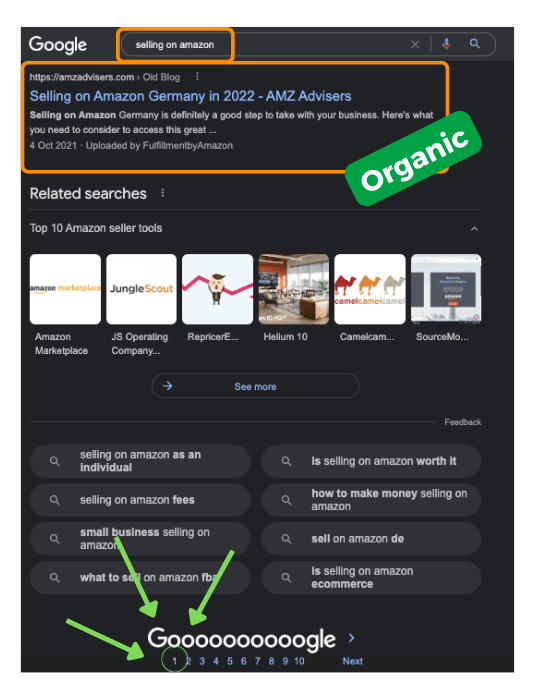Many companies that want to rank in the first page results of Google struggle to decide between two of the most discussed search strategies: SEO vs SEM.
According to Baclkinko, Google’s click-through-rate (CTR) for the second page of organic search results is 0.78%. In contrast, the first page results get 37.1% of user clicks.
Such stats confirm the importance of boosting your CTR to improve your web traffic. But how can you do so? Well, there are two main strategies you can use: SEO vs SEM.
Most marketing professionals confuse these terms. But Search Engine Marketing (SEM) is not a synonym for Search Engine Optimization (SEO).
Both strategies are closely related, but they get results using different marketing approaches.
Below, we’ll explain what SEO vs SEM is, and the difference between them. Plus, you’ll learn how each strategy can boost your brand awareness.
What is SEO?
Let’s kick off with the basics of SEO, which is short for Search Engine Optimization.
SEO focuses on improving traffic using organic tactics.
Here are some of the key goals of SEO are the following:
- Boost brand awareness on search engine result pages (SERP).
- Nurture long-term brand authority with target audiences.
Since SEO focuses on driving organic web traffic, you won’t rely on paid ads to boost your search ranks.
Rather, you’ll first focus on content design, such as social media posts, videos, and blogs. Then, you’ll work on keyword placement.
As you know, keywords are terms that users type in to find specific results online. Brands can use 2 types of keywords for an SEO campaign:
- Frontend keywords. Search terms used to create brand content. There are directly related to you and are visible to the end-user.
- Backend keywords. These are terms that are ‘hidden’ behind the content, so users can’t see them. Yet, they can help widen your SERP reach.
The key to a successful SEO campaign is to create a strong brand-keyword association. Here are the stages of the process:
- Keyword research. Find and target terms that your customers search for.
- On-Page SEO. Create valuable content for said users.
- Off-Page. Nurture user trust and build up your brand authority.
- Technical SEO. Make sure SERPs can find and index your content.
Following these steps will help you stand out in Google and other SERPs.
So, when a user types in a term that’s related to your brand, they’ll find you at the top results.

Related content: How to Use Amazon Backend Keywords
What is SEM?
As we said above, SEM is short for Search Engine Marketing. Just like with SEO, the goal of SEM is to improve SERP results for your brand.
However, SEM has a wider scope to work with, because it relies on both SEO and paid ads to drive visibility. So, SEM marketing includes SEO strategies, and also such as pay-per-click (PPC) marketing.
What Is PPC?
PPC is about setting up ads to attract specific users in the short term. They are digital billboards that showcase your value to users.
The goal of PPC marketing is to drive user conversions.
PPC ads appear alongside organic search results. But you’ll benefit from appearing in the first spots since you’ll be paying for that privilege.
But here’s the perk of PPC: you won’t pay for setting up the ad. You’ll only pay a fee for each user that clicks your ad.

PPC fees depend on the ad’s visual quality and keyword relevance. Yes, PPC ads also rely on keywords. That’s what’ll make your ad appear to online audiences.
Once you select the most relevant keywords for an ad, the SERP will offer a fixed bid to pay for the search term.
When a user types in the keywords, the SERP will display your ad. If the user then clicks on the ad, you’ll pay the approved bid for that single click.
Extra SEM tools
Some other great SEM tactics are link building and Search Engine Reputation Management (SERM).
Here’s what these two are about:
- Link building. Boost traffic using external and internal links that lead users to your website. It’s one of the key tactics to solidify your brand authority.
- SERM. Use content to establish your brand as an authority with your target audience.
In time, the search algorithm will detect your efforts, and place your content at the top of the ranks.

Differences Between SEO vs SEM Marketing
SEM refers to an array of organic and paid marketing strategies. In contrast, SEO only encompasses an organic marketing effort.
Both strategies aim to increase conversions and boost web traffic. But SEO goes at it with a narrower approach, while SEM covers a broader scale.
Let’s take a look at the key differences between SEO vs SEM marketing:
Goals and Reach
SEO uses Link building, content, and keywords to improve organic SERP ranks. SEM can rely on PPC ads to showcase results in the paid area of search pages to drive conversions.
Also, note that SEO marketing is limited to boosting your ranks on SERPs. Now, PPC ads can cover a wider scope, including social media sites and online marketplaces.
Time and Cost
SEO requires almost no capital investment. However, it focuses on long-term results, and it’s a time-consuming effort. According to Ahrefs, it may take 2 years to reach Google’s first page.
But you can still reap great results during the first months of your SEO strategy. That is, if you favor long-tail keywords, and relevant search terms to your brand.
The opposite scenario is true for PPC.
Hearst Bay Area states that Google’s average CPC is $1-$2. Depending on your CTR, one monthly PPC campaign could cost around $250 to $1000.
When to Use SEO vs SEM?
So, which is the best option for you? Actually, there’s no ‘better’ when it comes to SEO vs SEM. But sometimes you’ll get better results from one or the other, depending on your strategy.
SEM
We’ve learned that SEM includes both SEO and PPC marketing. When using the latter, brands can reap quick leads, with a budget of their choice, to boost revenue.
The advantage of PPC is that it targets interested customers. It takes less time to find an audience because users already know you.
So, the PPC approach will result in almost-certain conversions. And yes, you’ll have to invest in each click you get, but you’ll also drive profit and visibility.
SEO
SEO shines when you want to reap long-term results. Plus, the benefits of SEO won’t fade away so quickly. In contrast, PPC benefits only last until your ad bid runs out.
This is the way to go to strengthen your web traffic. That’s because you’ll share relevant content with your audience.
In time, they’ll come to rely on you as an authority within your market base.
All it takes is great keywords and relevant content. This makes SEO a very cost-effective strategy for up-and-coming brands.
Related content: Improve Your Content Marketing Strategy
Final Thoughts
It’s quite possible to boost your CTR by 30.8% only moving up one spot in Google search, according to Backlinko. And as we’ve explained today, SEM and SEO may help you hit that goal.
SEO marketing relies on keywords and valuable content. It’s great to build your long-term authority with target audiences.
SEM encompasses both SEO and PPC strategies. Its SERP marketing focused on wide, medium-term goals for brand visibility.
Now, which should you choose? There’s no “better” or “worse” strategy. In fact, it’s best to use both simultaneously.
In the end, a full-fledged SEM campaign will include SEO and PPC marketing. And both strategies are key tools to boost your SERP ranks.
Author

Esteban Muñoz is a content writer at AMZ Advisers, with several years’ experience in digital marketing and e-commerce. Esteban and the AMZ Advisers team have been able to achieve incredible growth on Amazon for their clients by optimizing and managing their accounts, and creating in-depth content marketing strategies.



